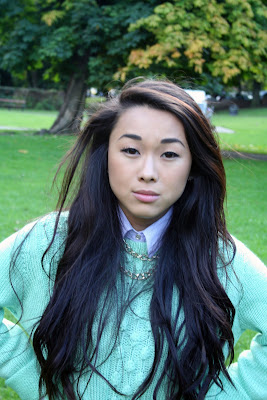Shown above is my front cover design for my magazine 'Unconventional'.
Below are some other images that I took of my subject for my front cover. All the images are raw and unedited.
The image above I should have used the 'T-stance' to get a better head and shoulder shot rather than a body shot of the subject.
With the first image I like how the subject is stood at an angle rather than straight on looking at the camera. However I think I should have used the focus ring so that the image is less blurry.
The second imafe I like as image as the background is sort of naturally blurred out so that Kay is the main focus within the image. Again I could have used the T-stance so that I got a closer image on Kay's face.
Induction Evaluation.
In order to create my front cover I used manual focus and took the photos in portrait mode as we were photographing people rather than a landscape. The zoom ring on the camera means you can zoom in and out on the focus of your image depending on what detail you want to capture in the image. With the photos that I took I used the zoom ring in order to capture a closer image on Kay's face for my front cover and I used the focus ring to make sure that the image was clear. The majority of my images used the rule of thirds with the eyeline in the correct place, however some of my shots meant that the eyeline was not in the correct place, this is something I could improve on and better myself at sp the images I take will oblige with the rule of thirds. I learnt that different lighting (such as back, side and front) exposes the pictures in different ways. With the background I didn't think about the background but in future as an improvement I should carefully think about the background so that it is relelvant to the magazine, the image and particular topic that may appear within my magazine.
When it came to handling my subject (Kay) I think that I maybe could of handled her better, maybe asked her to pull a particular face or pose to go with the magazines image. I do feel that we did try to communicate with each other as best we could but it was still quite awkward between us as we don't know each other very well. I feel that just relaxing and having a laugh will make the images easier to capture rather than having you subject being stiff and awkward as they may not be used to having their picture taken so intimately and in-your-face. I don't think my lack of people skills effected my images too much as I still took a few good shots. I'd probably take better shots with the improvement of my people skills and feeling comfortable around other people/subjects.
In order to create my front cover we used photoshop. I'd never used photoshop before up until I started doing media as a subject. One of the tools I used was the text tool to put text onto my front cover so that it wasn't a blank image. I also used the grab tool to move my text and images I input to move them around to where I thought they were better suited. I found that trying to make my text stand out against my subject's dark hair difficult up until I used stroke and bevel and emboss to highlight the outside of the etxt to make it stand out. Varying the stroke and bevel and emboss effect meant that the text on my image stood out in different ways. I found adding text was easy but difficult to control. I experimented a bit and got the hang of controlling the text and adding effects so that the text wasn't plain and boring. I did not drop shadows on my front cover as I didn't think it looked right. In order to have my own font I went on Dafont.com to pick a font that suited my magazine. I downloaded the font, and sent it to 'Fonts' in the 'WINDOWS' file on my computer, I then copied and pasted it into the 'Fonts' folder. I chose to use Two O'Clock as the font because it stood out and I feel it works with the name of my magazine 'Unconventional' means to be different as such and I think the font goes well with that. The colours I used for the name of the magazine were made up of pink as the inner colour and black for the bevel and emboss so that it's the first thing that your eyes get drawn to on the title page. It's different and recognisable. The other texts were not as vibrant as the title but a lot of the sell lines were bevelled and embossed to stand out as well to catch the readers eye. To improve my front cover I'd want to have my image of Tay Jardine faded so that she was in the background as such rather than on a white backdrop so it takes up less room. I feel that if I knew more about photoshop I could greatly improve my front cover and I feel that's something that I need to improve on as a target for myself. However overall I feel I did quite well with my front cover considering I know very little about photoshop or camera work, the image fits well and isn't stretched or blurry and the text stands out so that it is eye catching. I also think that the pricing and bar code make it look a lot more realistic. The subjects eye line is on the rule of thirds and the head and shoulder shot works great.

























